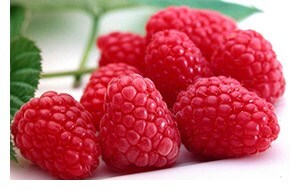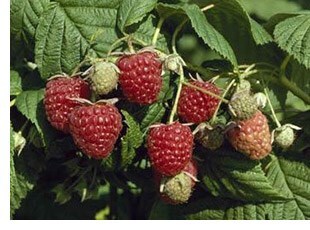Raspberries
 Just from time to time, while footling about in the garden, you pop something in your mouth in passing and everything stops while you’re transported into another plane of total ecstasy. The kind of closed-eyes, blissed-out ‘mmmmmm’ moment that only people who grow their own food get to experience.
Oh, all right, I’ve seen a similar expression on the faces of student friends who popped over to enjoy a chocolate fondue, but chocolate fondues, while one of those essential bucket-list experiences everyone should have at least once in a lifetime, are not something you can do every day (not if you want to live past 30, anyway). Whereas eating an overflowing fistful of perfectly ripe, plump raspberries fresh from the cane most certainly is.
Just from time to time, while footling about in the garden, you pop something in your mouth in passing and everything stops while you’re transported into another plane of total ecstasy. The kind of closed-eyes, blissed-out ‘mmmmmm’ moment that only people who grow their own food get to experience.
Oh, all right, I’ve seen a similar expression on the faces of student friends who popped over to enjoy a chocolate fondue, but chocolate fondues, while one of those essential bucket-list experiences everyone should have at least once in a lifetime, are not something you can do every day (not if you want to live past 30, anyway). Whereas eating an overflowing fistful of perfectly ripe, plump raspberries fresh from the cane most certainly is.
Round about mid-August, my sworn allegiance to the strawberry as my all-time favourite fruit starts to wobble as the first fruits of my summer raspberries, ‘Glen Ample’, start appearing on the canes. But when the far heavier-cropping ‘Autumn Bliss’ is in full flow as well, I treacherously hand over my heart fully and passionately to the raspberry.
 I secretly prefer autumn raspberries, though I do grow both types. Summer raspberries are prima donnas: they crop fitfully for me, and I’ve never quite understood why it’s accepted wisdom that summer varieties are heavier yielding and more reliable. Perhaps it’s because I’m a softy southerner summer (raspberries are also said to do better in cooler climates) but I’ve always found quite the opposite: autumn raspberries start being productive sooner, crop more heavily and go on for weeks longer than summer ones. In fact my ‘Glen Ample’ canes are going to have to pull their little raspberry fingers out if they want to cling on to garden space in my fruit patch. Even more so since I recently discovered double cropping: a crafty little pruning technique which means you can have raspberries from July to the first frosts, from the same canes. If space is limited, it’s the only way to grow.
I secretly prefer autumn raspberries, though I do grow both types. Summer raspberries are prima donnas: they crop fitfully for me, and I’ve never quite understood why it’s accepted wisdom that summer varieties are heavier yielding and more reliable. Perhaps it’s because I’m a softy southerner summer (raspberries are also said to do better in cooler climates) but I’ve always found quite the opposite: autumn raspberries start being productive sooner, crop more heavily and go on for weeks longer than summer ones. In fact my ‘Glen Ample’ canes are going to have to pull their little raspberry fingers out if they want to cling on to garden space in my fruit patch. Even more so since I recently discovered double cropping: a crafty little pruning technique which means you can have raspberries from July to the first frosts, from the same canes. If space is limited, it’s the only way to grow.
 Autumn-fruiting raspberries are usually pruned just once a year, in midwinter: you just work your way along the row, take out all the canes down to the ground, and that’s it. They fruit on this year’s new growth (unlike summer raspberries, which fruit on one-year-old stems), so the new canes which emerge in spring will bear that year’s fruit.
Now forget all that and throw the pruning book out the window. There’s another way of doing it that brings the harvesting season well into summer – giving you months more berries.
It’s pretty straightforward. At the end of autumn, instead of cutting the whole stand to the ground, prune out only the canes which have fruited, leaving the others in the ground (a little like you would for summer types). These grow on into next year, fruiting much earlier than usual and giving you your summer crop. Next spring’s shoots still emerge, just as they would normally, giving you an autumn crop, too. Et voilà: summer and autumn raspberry crops on the same canes.
Autumn-fruiting raspberries are usually pruned just once a year, in midwinter: you just work your way along the row, take out all the canes down to the ground, and that’s it. They fruit on this year’s new growth (unlike summer raspberries, which fruit on one-year-old stems), so the new canes which emerge in spring will bear that year’s fruit.
Now forget all that and throw the pruning book out the window. There’s another way of doing it that brings the harvesting season well into summer – giving you months more berries.
It’s pretty straightforward. At the end of autumn, instead of cutting the whole stand to the ground, prune out only the canes which have fruited, leaving the others in the ground (a little like you would for summer types). These grow on into next year, fruiting much earlier than usual and giving you your summer crop. Next spring’s shoots still emerge, just as they would normally, giving you an autumn crop, too. Et voilà: summer and autumn raspberry crops on the same canes.
You can do this with just about any autumn raspberry variety. Most will yield a higher weight of fruit under a double-cropping system: in a recent Which? trial the ‘Autumn Bliss’ harvest rocketed from 2.5kg on a conventional system, to 5.75kg when double-cropped. And anything which more than doubles your raspberry-eating pleasure has got to be worth a try.



 Just from time to time, while footling about in the garden, you pop something in your mouth in passing and everything stops while you’re transported into another plane of total ecstasy. The kind of closed-eyes, blissed-out ‘mmmmmm’ moment that only people who grow their own food get to experience.
Oh, all right, I’ve seen a similar expression on the faces of student friends who popped over to enjoy a chocolate fondue, but chocolate fondues, while one of those essential bucket-list experiences everyone should have at least once in a lifetime, are not something you can do every day (not if you want to live past 30, anyway). Whereas eating an overflowing fistful of perfectly ripe, plump
Just from time to time, while footling about in the garden, you pop something in your mouth in passing and everything stops while you’re transported into another plane of total ecstasy. The kind of closed-eyes, blissed-out ‘mmmmmm’ moment that only people who grow their own food get to experience.
Oh, all right, I’ve seen a similar expression on the faces of student friends who popped over to enjoy a chocolate fondue, but chocolate fondues, while one of those essential bucket-list experiences everyone should have at least once in a lifetime, are not something you can do every day (not if you want to live past 30, anyway). Whereas eating an overflowing fistful of perfectly ripe, plump  I secretly prefer autumn
I secretly prefer autumn 
